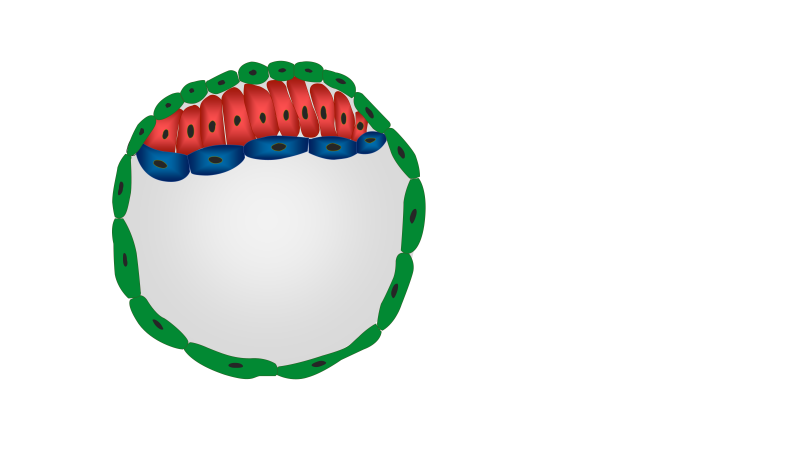October 4 is Pluripotency Day where we get to celebrate stem cells. As part of our celebrations, we asked one of our Group Heads Harry Leitch to share some thoughts about the wonderful thing that is pluripotency.

In recent years, October 4th has been marked as Pluripotency Day. A niche festival for sure, and some way behind Star Wars Day and even Ed Balls Day in capturing the public’s imagination. However, it is a chance for stem cell geeks across the world to celebrate and reflect on the many advances that have been made in the field of pluripotent stem cell biology.
The field has made considerable progress since the Nobel Prize-winning discovery of embryonic stem (ES) cells in 1981. Perhaps most famously, this led to the discovery of induced pluripotent stem (iPS) cells in 2006 by Shinya Yamanaka. iPS cells have all the properties of ES cells, but instead are derived from adult cells, essentially taking them back in time to a more embryonic state. The development of human iPS cells has opened up a wide range of possibilities in regenerative medicine, and this technology is now entering clinical trials for a number of conditions. As a result, another Nobel Prize followed suit in 2012.
But what is pluripotency?
The exact definition of this word remains disputed, even among experts in the field. Can we settle this argument semantically? Not really. Potency is easy to define – this is the range of differentiation options open to a cell; or the different cell types a stem cell can mature into. All stem cells have a potency as making other cell types is the key job of a stem cell. In addition, stem cells can self-renew, which means making an exact copy of themselves. Pluri- means many, so pluripotent literally means the ability of a cell to make many types of other cells. Historically, this is how the word pluripotency was used, and as such scientists used it to describe lots of different types of cells. This wasn’t particularly helpful, and we no longer use it this way. For example, we have stem cells in our bone marrow which can make all of the many different cell types in our blood. Rather than referring to them as pluripotent, as was done in the past, we now refer to them as multipotent. A multipotent stem cell can make many or all of the cells within a given tissue – so blood stem cells make all the cells in our blood, skin stem cells maintain our skin, and different types of gut stem cells maintain the lining of our gut. These cells are quite specialised – they stick to making one tissue and don’t swap. But pluripotency is more than this. At the very least we use the word to mean ‘making all the cells in the adult body’.
Which cells can do this?
Firstly, there are cells in the very early embryo that do this job. Most of the work in this field has focussed on mouse embryos – although many of the principles are likely to hold true in human development. In the mouse, the embryo just prior to implantation is a very simple structure.

Image shows a diagram of the mouse pre-implantation embryo. Red shows the epiblast which will give rise to the embryo, blue is the primitive endoderm which will give rise to the yolk sac, and green is the trophectoderm which will develop into the placenta.
There is an outer layer that will make the placenta (green), and a ball of cells in the middle. The outer rind of this ball will contribute to the yolk sac (blue), which is another supportive structure for the embryo. But right in the middle are 20-30 cells, called epiblast cells (red), that will go on to build the embryo, which develops into a fetus and eventually the adult organism. Each of these epiblast cells are identical and can make all cell types – these cells are described as pluripotent.
Simple then? Well not quite. Epiblast cells are the cell of origin of embryonic stem (ES) cells: if we put them in culture in the right conditions, they start to self-renew and form stem cell lines. The great advance of ES cells is that they can be manipulated in culture and put back in the embryo and re-enter development; they remain pluripotent. This can be visualised as they contribute to all the different tissues in the organism.

Image of rat chimeras. The green cells are derived from cultured pluripotent stem cells.
So, what’s the problem?
Well there is recent interest, and some disagreement, about whether ES cells can also make a meaningful contribution to the extra-embryonic structures – those other two layers of the early embryo that make the yolk sac and the placenta. In some ways this is old news. The very first investigation into the potency of ES cells reported that they could contribute to these structures, albeit with low efficiency and within the limitations of the techniques available at the time to assess this. Recent studies have reported similar findings to a lesser or greater degree. In simple terms, the debate around pluripotency is whether the definition should include the ability to make these extra cell types or not. Some researchers have suggested we need another word to help distinguish these two options, while others are less clear this is such an important distinction to make. While this debate is unlikely to be settled any time soon (or to everyone’s satisfaction) one thing is for sure, the etymology and historical usage of the word pluripotency will not be of much use here.
If a stem cell can make both embryo and placenta, could it be placed in a mother’s womb and make a baby by itself? Currently it seems very unlikely that we could make a stem cell like this. In fact, this property has a different name – totipotency. Totipotency is quite distinct from pluripotency (however defined), and in many ways is a concept we are all more familiar with. We all know that when a sperm fertilises an egg, this single cell can ultimately make a baby – this is totipotency. Without starting with an egg, it seems very difficult to imagine that we can build such a totipotent cell in the laboratory. However, predictions in this field are a dangerous business, and I’d be delighted to be proved wrong!
A final comment on the importance of nomenclature. October 4th was designated pluripotency day in honour of Oct4 – the most important gene that regulates pluripotent cells. Strictly speaking, some would argue that this gene should be called Oct3/4 as the early labs that discovered and characterised this gene began by calling it different names – either Oct3 or Oct4. Certainly, Oct4 rolls off the tongue more easily and so my habit is to stick to this name. However, I propose a new tradition – that we celebrate pluripotency and pluripotent stem cells as the clock strikes midnight on the 3rd October, right on the Oct3/4 boundary. We can toast all the researchers involved in discovering this gene and indeed, all the groups worldwide who continue to make amazing discoveries that renew our understanding of pluripotency. Cheers!
